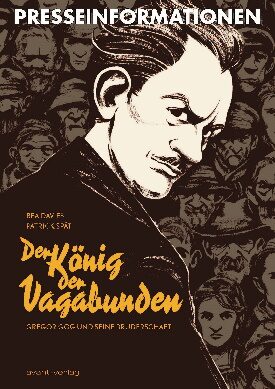Patrick SpätBea Davies
Der König der Vagabunden. Gregor Gog und seine Bruderschaft
[King of the vagabonds. Gregor Gog and his brotherhood]
- avant Verlag
- Berlin 2019
- ISBN 978-3-96445-015-9
- 160 Pages
- Publisher’s contact details
Published in Greek with a grant from Litrix.de.
Sample translations
Tramp and anarchist
This graphic novel, the first biography of the historical figure Gregor Gog (1891-1945), seeks to remind us in no uncertain terms of his life and activities. Born in Prussia, the young Gregor Gog gained his initial experience of ‘vagabondage’ as a common seaman on the world’s oceans, before becoming an unwilling participant in the First World War as a naval conscript and taking part in the Kiel mutiny in 1918. Following the war, spurred on by anarchist literature and by people who shared his political views, he embraced a life of vagabondage out of sheer conviction.
Together with other anarchists Gog founded the ‘Kommune am Grünen Weg’ in Bad Urach near Stuttgart, which became a centre for free thinkers, writers and artists of every sort, including Theodor Plievier, Johannes Becher, Erich Mühsam and Gusto Gräser. Besides political writings advocating the rights of the homeless, Gog’s main achievements were to found the ‘Brotherhood of Vagabonds’ in 1927, organise the ‘1st International Congress of Vagabonds’ in 1929, and produce Europe’s first street newspaper, Der Kunde.
Author Patrick Spät, born 1982, based his narrative on highly detailed research into Gog’s eventful life, and he also provides a deeply thoughtful afterword full of interesting supplementary details. Spät establishes a framework for the story by choosing to begin and end it with an episode in the winter of 1933-34 when Gog evaded the nazis by escaping from a concentration camp and fleeing to Switzerland. The book leaves aside Gog’s later years and their tragic outcome in order to focus exclusively on his evolution during his early years and the culmination of his achievements during the 1920s. Gog appears here as the eloquent spokesman of the Bad Urach circle who made it his business to fight for the homeless. Around 1930 he was increasingly attracted to Soviet communism, whilst refusing to acknowledge its darker side.
The illustrator and graphic artist Bea Davis, born 1990, is the creator of the book’s impressive black and white drawings, having already made a name for herself in Berlin’s indie scene with a variety of comic-strip ventures - including a series on the homeless in the Berlin of today. Her atmospheric ink drawings are characterised by stark contrasts, and as such are reminiscent of Expressionist graphics and powerfully evocative of Wilhelmine Germany and the Weimar Republic. Her expressive depictions of Gog convey his unyielding resolve with particular clarity. Between them Davies and Spät thus succeed very well in reintroducing today’s readers to the ‘vagabond movement’ that in its day caused such a stir, while also providing a touching portrait of its charismatic leader.
Translated by John Reddick

By Ralph Trommer
Ralph Trommer, Dipl. Animator, is a freelance writer and artist who is a regular contributor of reviews and articles on comics, graphic novels and films for a variety of media.
Publisher's Summary
Patrick Spät / Bea Davies (illustrator)
Der König der Vagabunden. Gregor Gog und seine Bruderschaft (King of the vagabonds. Gregor Gog and his brotherhood)
‘Paradise starts where the bourgeois ends.’ (Gregor Gog)
Stuttgart, Whitsuntide 1929: the police are setting up roadblocks, padlocks have sold out right across town. Gregor Gog (1891-1945), famous throughout the land as ‘king of the vagabonds’, has summoned tramps from everywhere to attend an International Congress of Vagabonds and is calling for a ‘lifelong general strike’. Two years earlier the former seaman Gog had founded the ‘Brotherhood of Vagabonds’ in order to help the homeless and organise them politically; in the same year he had begun publishing Der Kunde, Europe’s first street newspaper.
Throughout his life Gog fought against exploitation, fascism and racism. Der König der Vagabunden depicts the itinerants of the 1920s and their lives full of dangers and privations, and includes extensive original material from the period.
A graphic novel about poverty and hope, friendship and protest - and about a forgotten aspect of the Weimar Republic.
(Text: avant Verlag)
